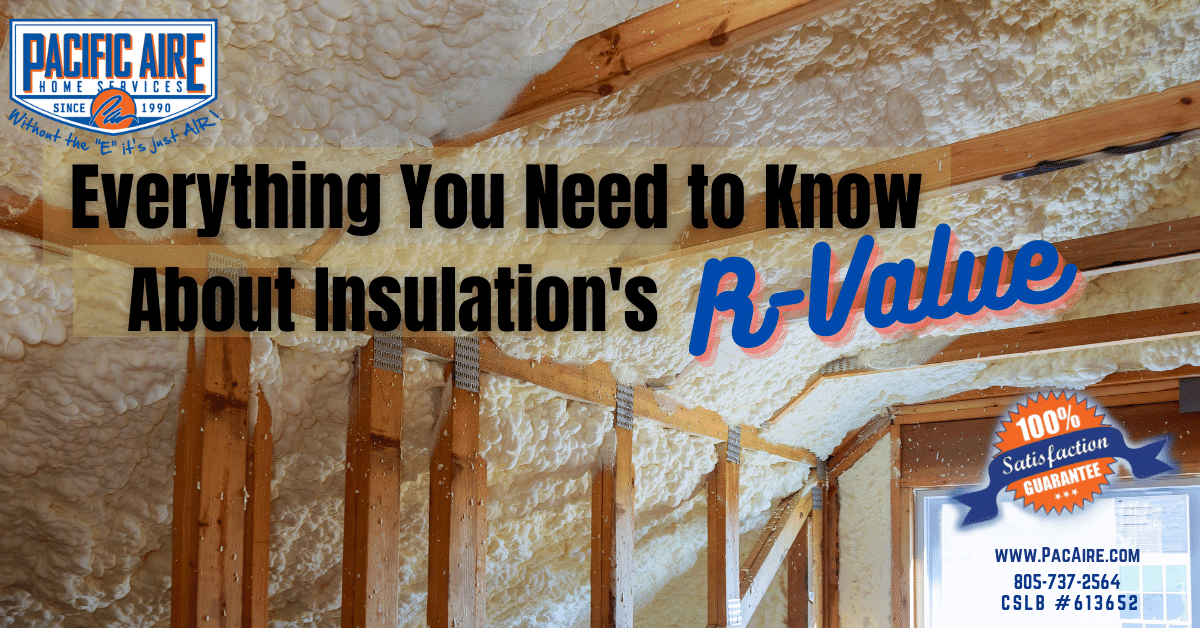Homeowners always ask us how they can increase the energy efficiency of their homes. Although heating and cooling are expensive necessities, there are certainly ways to be smart about them.
Professionally insulating your attic can help ensure your home is as energy-efficient as possible during the cold months. When properly insulated, hot air is trapped in and cold air is kept out – the opposite happens in summer.
It is likely that you have some insulation, but there are certainly some issues that impact the efficiency of your HVAC system and insulation.
It is estimated that 9 out of 10 American homes are under-insulated, according to Energy Star.
You should reassess your energy use for the months ahead. With annual maintenance and services such as professional insulation, your home can become an energy-efficient model for the local community.
Pacific Aire specializes in insulation services since we understand the importance of home comfort and energy savings. Most HVAC companies do not offer insulation because it is complicated, time-consuming, and expensive. Your property will be inspected by a certified HVAC technician who specializes in insulation and offers energy-saving solutions based on the findings.
Insulate your Attic for Higher Energy Efficiency
A good place to start is your attic if you want to add insulation to your home. Heat and cold can easily leak into a house if the attic is not properly sealed and insulated. This strains your heating and air conditioning systems, increasing your energy bills and increasing the need for repairs. Summers and winters can be unbearably hot or cold so make sure to consider insulating your attic as soon as possible.
You may wonder, though, how can you tell whether your attic insulation is enough?
How does R-value work? What is the correct amount of attic insulation to have?
R-value refers to the thermal resistance of insulation, building materials, or components. The R means resistance.
R-values measure the level of insulation. The greater the R-value, the more effectively your insulation resists the flow of heat. In general, the higher the R-value, the better it insulates per inch of thickness. According to Energy Star, here are the Recommended Home Insulation R-Values.
An insulation’s R-value is determined by four factors in general:
- – Thickness
- – Amount of density
- – Installation (how and where it is installed)
- – Type (e.g., cellulose, batted-fiberglass, blown-in fiberglass, or foam)
The importance of installing attic insulation properly for R-value
The denser and thicker the insulation, the better it will prevent heat from escaping. Furthermore, the type of insulation, whether it is loose fill cellulose or sprayed foam polyurethane, affects the R-value. The effect of how and where insulation is installed on R-value is less evident. If it is compressed during the installation process, which is common with DIY attic installations, its R-value will decrease.
If two layers of insulation are pressed together, the R-value will be doubled.
R-value is also affected by where insulation is installed. A typical attic ceiling contains many joints and studs. Heat travels much easier through these areas, so the R-value of the insulation isn’t as high. This is why you must choose the right insulation for your attic and choose the right R-value.
Attic Insulation: How Much Do You Need?
Insulation requirements will depend on where you live, but here are some general attic insulation guidelines: Homes in cold climates should have an attic insulation rating of R-49, or approximately 16 inches of fiberglass insulation. In warmer climates, the R-38 rating or higher is sufficient, or about 12 inches.
The attic floor joists may need more insulation if you can see them. Measure your attic first before you start thinking about adding more insulation. You’ll need gloves, a dust mask, and a ruler or yardstick.
Use this R-value map from Energy Star to determine your insulation requirements in your location. ENERGY STAR offers more attic insulation tips.
Options For Attic Insulation
It is essential that you improve the attic insulation as soon as possible. Here are the attic insulation options and their pros and cons. Call our friendly customer service representatives for more information.
At Pacific Aire, we care most about your home comfort. Our new attic insulation brings your home warm, cozy comfort this season.
Our Comfort Attic Package gives you the complete peace of mind that your home will get the best, without the hassle and stress. No Surprises, just exceptional service- because nobody cares like PACIFIC AIRE.
Visit https://bit.ly/pacificaire_attic_insulation or call us at 805-737-2564 to schedule your insulation today.


